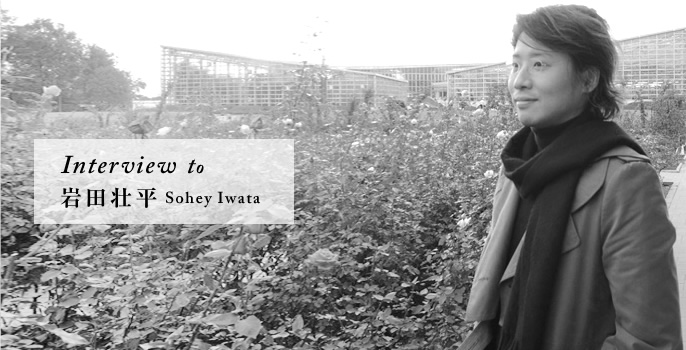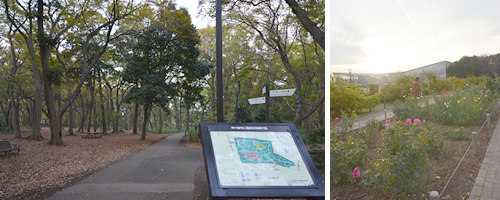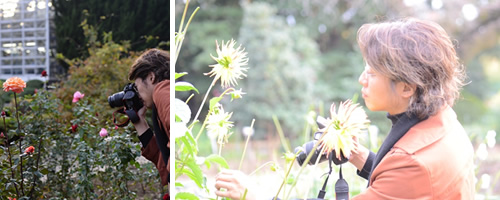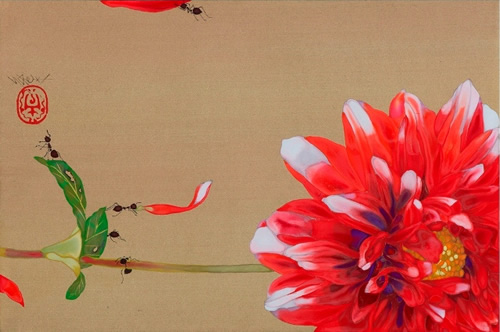
2012.1.20
An artist capturing the secret essence of flowers
An interview with Sohey Iwata
Iwaseki Tomoko, Gallery Sakuranoki
Date: 2012 1.20
A master painter of flowers in the traditional Japanese nihonga style. From his earliest years, having a deep affinity with flowers, Sohey Iwata chose the path of an artist and felt his vocation was to be a painter of flowers. He is now 33 years old and plays a brilliant part in livening up the Japanese art world. Gallery Sakuranoki has waited three years to host his solo exhibition, and every season we often heard of his work receiving high acclaim and awards. In step with a gardener’s floral calendar, around the time when a flower he wants to sketch is in bloom, usually about twice a month, Iwata visits Jindai Botanical Gardens adjacent to Jindaiji Temple in Mitaka City, Tokyo. It was on just such an occasion in the beautiful Jindai Botanical Gardens that we caught up with the artist, and while guiding us around, he spoke about his solo exhibition to be held in February.
The cut flowers we see in florists are, not surprisingly, very different from those growing in a garden; visiting flowers in a garden and walking among them in this way is not only the source of my creativity, but also an essential activity for me.
The Tokyo Metropolitan Jindai Botanical Gardens are the only municipal botanical gardens in Tokyo, and home to some 5,000 species and 100,000 plants thriving amidst the pleasant atmosphere of the Musashino district.
Sohey Iwata was born and raised in Nagoya, and at the age of 18 enrolled on the Japanese Painting Course of Kanazawa College of Art, and six years later, after graduating from the graduate school, he moved his studio to Tokyo. He studied under Reiichi Tsuchiya and received guidance from Hiroshi Senju; he is now 33 years old and along with twice receiving the Tokusen (special recognition award) in the Nitten Exhibition, he has the distinction of being the youngest member whose works need not be submitted to the jury. Eight years ago when he moved to Tokyo, he started paying frequent visits to these gardens.

Left: Entrance of the Jindai Botanical Gardens, Right: In the Rose Garden
“You probably know there is a calendar showing when each flower blooms. I often check it and think ‘Ah, good. Now is about the time that flower will bloom’ and I leave my studio for the day. I usually visit about twice a month.”
The day of the interview was a public holiday, and the gardens were packed, but Iwata said: “On weekdays, there are no visitors at all, which is good for me because I can immerse myself in the flowers.” He also confessed that when holding his sketchbook in one hand, he completely loses himself in drawing, and when he returns to the present, it is often pitch black outside.
“The cut flowers we see in florists are, not surprisingly, very different from those growing in a garden; visiting flowers in a garden and walking among them in this way is not only the source of my creativity, but also an essential activity for me.”

Left: Inside the gardens, Right: A praying mantis found in the Dahlia Garden!
“Since my childhood, I have been fond of flowers. I should say they are perfectly in harmony with me, and are the one theme that fascinates me the most. When I am painting them, if my feelings are unclear, then the painting doesn’t work. It is important not to have any resistance to flowers as they really are, just let them into yourself. But if I paint a flower exactly as I see it, it still would not be “just as it is.” I think I have to capture something intangible that maintains the figure of that flower, I have to capture this kind of power. Not only with my eyes, but also with every part of my body; I also need my feelings to sense it and hands to draw it. I believe that unless I’m seriously working there is something that I cannot see, something I will miss.”
His favorites are the Rose, Dahlia, and Peony Gardens. To complete one piece of work, he make several sketches, and after deciding the composition, he works on the honga (final version), and in the final stage, depicts the painted flowers by placing the real ones close to his side. He keeps painting and soaking every single petal with plenty of water, and patiently waiting for them to dry until he arrives at the perfect color. It is apparent that with this painstaking process, the number of works he can paint every year is limited, resulting in his admirers vying to acquire his work. “In spite of everything I can do, I am still unable to produce many works. I really feel sorry about that.”

Dahlia, mineral pigments on paper, 2011